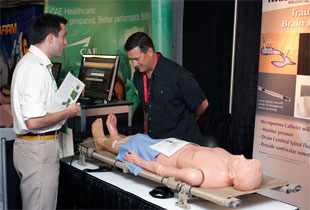Past Experiences Continue to Transcend Modern Military Medicine
Frontline warfighters are just that, out front and exposed to factors and circumstances that result in injuries and diseases that one in civilian medicine would not normally experience. War is often stated as the catalyst for advances in traumatic medicine.
The Advanced Technology for Applications and Combat Casualty Care conference of 2010 is about the evolution of trauma medicine. It is about partnerships and collaboration. It is also about learning from the past and identifying the needs of the future.
It was during war that great ideas such as the tourniquet or the use of helicopters for patient transport were introduced. Both rolled over into civilian medicine. The tourniquet, introduced almost 300 years ago continues to be the most efficient tool to control bleeding that exists today.
Maj. Gen. James Gilman, commander of U.S. Army Medical Research and Materiel Command said, "You have no idea how much good everyone here is doing. Not only for Combat Casualty Care but your work more importantly continues to prevent injuries and save lives."
He went on to say that it is almost like the work done by attendees has gone viral, it has spread and now everyone needs the end results immediately.
It is because of the work of everyone involved in trauma medicine that the survivability rate in the field is nearly 90%. That success rate gives Soldiers the confidence to see thru and carry out their assigned missions. The conference brought together experts from academia including the University of Pittsburgh as well as partners with products that are being used in the field. The two biggest hurdles which continue to result in severe debilitation or fatalities are traumatic brain injury and hemorrhaging.
TBI has multiple causes as well as multiple possible treatments. Speakers included a NFL physician who discussed experience in the field of sports medicine and the use of the Immediate Post Concussion Assessment and Cognitive Testing. This test has become the most widely used concussion evaluation system with over one million tested. He stressed the importance of having a baseline to work with and how it may be useful for the military to consider information gathered from other possibly debilitating professions such as football or boxing.
Dr. Patrick Kochanek, professor of critical care and director of SAFAR Center at the University of Pittsburgh discussed the ongoing program, Operation Brain Trauma Therapy. The use of multiple models, species and outcomes has the potential to provide insight into therapies for TBI. As information evolves regarding the role axonal injuries play in TBI, the program which assesses appropriate treatments, is searching for therapies that are beneficial, including U.S. Food and Drug Administration licensed products and experimental products.
Controlling bleeding that can't be reached remains a priority among military healthcare professionals. Injuries to the chest, abdomen and pelvic area where a tourniquet can't be placed remain a concern. With that, several companies are working with the Army on developing freeze dried plasma as well as frozen blood products. The Army continues to work and develop these potentially lifesaving products. Clinical trials are ongoing and a necessary step towards product approval of the FDA.
Many U.S. Soldiers are in top physical shape. Often this makes it difficult to diagnose or treat. The conference is allowing attendees to share information and the opportunity to join forces to improve trauma medicine for the Soldier.
The rest of the week will focus on clinical trials and developments in hematology, neurology and burns.
The conference continues to bring information to the table where everyone involved has a single mission: the care of the warfighter.















